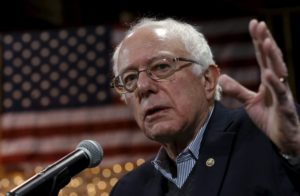Word is that Democratic officials are hoping to heal the rift between Hillary Clinton and Bernie Sanders supporters. It’s a good goal, even if the action behind the intent points to a questionable start.
An agreement allowed Sanders to select five people to serve on the party’s platform committee at the national convention in Philadelphia this July, which is roughly one-third of total membership. Clinton selected six including committee leadership, giving her campaign a controlling interest, and U.S. Rep. Debbie Wasserman Schultz, who leads the Democratic National Committee, named the remaining four.
This is a deviation. Previously and typically the DNC head names the entire slate, presumably with the blessing of the presumptive or actual presidential nominee. Since Sanders and his supporters have worried their policy proposals, especially those in relation to income inequality, would receive little party attention and support, the platform committee shift is being applauded by Sanders and his supporters.

“We believe that we will have the representation on the platform drafting committee to create a Democratic platform that reflects the view of millions of our supporters who want to the party to address the needs of working families in this country and not just Wall Street, the drug companies, the fossil fuel industry and other powerful special interests,” Sanders said in a statement.
Sanders’ appointments, announced Monday, include academic Dr. Cornel West, pro-Palestinian activist James Zogby, progressive ally U.S. Rep. Keith Ellison, environmentalist Bill McKibben and Native American rights advocate Deborah Parker. (That’s one female appointee, if you are like me and prone to count such things.)
As far as teams go, this one meshes well with the policy positions the Sanders campaign hopes to solidify as a part of the party’s platform.
Unfortunately, the party platform is of little more consequence than a salad bar at a strip club. No one is really paying attention to it, and even those responsible for it can’t help but view it as sketchy.
Those familiar with party politics, especially those who have been part of county, district and state conventions that have extended into the wee hours due to squabbles over the platform, may find this assertion odd. Why would so many fight so hard over something if it doesn’t actually matter? That’s a good question, and one that I’ve asked many times.
No elected official is required to follow the platform, or to agree with it, in whole or in part. There is no clause that says Democratic candidates must adopt 70, 50, 30 or even 10 percent of what’s written there. There is no rule that bills submitted in Congress should be based on anything within the platform, or that a certain percentage of votes should align with platform policies.
The 2012 Democratic platform, for instance, states: “We are expediting the approval process to build out critical oil and gas lines essential to transporting our energy for consumers.” Such a statement stood in direct contrast to President Barack Obama’s action on the Keystone XL pipeline.
Likewise, the previous platform called for the death penalty to “not be arbitrary,” meaning that “DNA testing should be used in appropriate circumstances, defendants should have effective assistance of counsel, and the administration of justice should be fair and impartial.” Nevermind that the historical and well-documented prejudicial nature of capital punishment is the crux of the problem.
Although most Democrats, and many Democratic elected officials, pledge not to cut or privatize Social Security, Medicare and Medicaid, there is no such pledge in the 2012 platform. There is no clear statement that these relied upon safety nets should be a funding priority.
Perhaps in a response to the 2008 presidential campaign and strong public sentiments against warrantless citizen surveillance, racial profiling, torture and use of detention facilities at Guantanamo Bay, the 2008 Democratic platform was clear on such civil liberties questions. Four years later, the platform was effectively silent.
On both sides of the political aisle, party platforms have been used by presidential nominees to bump support of their key objectives among members of the party base. Rarely, if ever, has it successfully served as a vehicle by which the base could elevate their message to those in power.
It’s a mission statement posted on a website, but otherwise forgotten. It’s a statement of beliefs that isn’t required, or necessarily welcomed. It’s a reminder of what a certain group of party activists want, which often differs greatly from what a candidate knows will result in election night victory.
Even as Sanders and his supporters applaud their ability to make the DNC’s needle move, to force a change in convention policy, they are playing a short, unessential game. They won something that is essentially meaningless.
This column by Lynda Waddington originally published in The Gazette on May 22, 2016. Photo credit: Jim Young/Reuters
